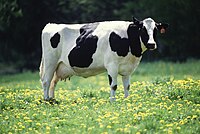
Photo from wikipedia
The study investigated the effect of chop length of wheat straw in a high-straw dry cow diet on the feeding behavior, health, and performance of Holstein dairy cows across the… Click to show full abstract
The study investigated the effect of chop length of wheat straw in a high-straw dry cow diet on the feeding behavior, health, and performance of Holstein dairy cows across the transition period. Forty cows were enrolled at dry off, approximately 45 d before expected calving, and assigned to 1 of 2 dietary treatments containing (on a dry matter basis) 36% corn silage, 35% dry cow pellet, and 29% wheat straw. Diets were formulated to target an energy consumption of 19 Mcal/d of net energy for lactation per cow. The diets differed in the chop length of wheat straw: (1) long straw chopped with a 10.16-cm screen (LDD; n = 20), or (2) short straw chopped with a 2.54-cm screen (SDD; n = 20). Dietary treatments were fed throughout the dry period. Feeding behavior, rumination time, and reticulorumen pH were monitored electronically, and feed samples were collected to determine feed sorting. Blood samples were taken weekly, and body condition scores and body weights were taken every 2 wk. Postcalving, all cows were fed the same lactating cow total mixed ration for 28 d; the same measurements were recorded with the addition of daily milk yield and twice weekly milk components. During the dry period, cows fed the SDD treatment consumed more dry matter (15.6 vs. 15.0 kg/d), had more consistent dry matter intake in the week leading up to calving, had a faster feeding rate, consumed 0.4 kg/meal more, and had 0.6 fewer meals per day. No differences were observed in rumination time or mean reticulorumen pH between treatments in both the dry and lactating period. Regardless of treatment during the dry period, cows sorted against the long particles (>19 mm) and in favor of the short particles (<8, >4 mm), but cows fed the LDD treatment sorted to a greater extent than cows fed the SDD treatment. Dietary treatment in the dry period did not influence feed sorting behavior postcalving. Cows fed the LDD treatment had a greater daily change (decline) in rumen pH in the first week postcalving and had a greater blood β-hydroxybutyrate concentration in the third week postcalving. Overall, the results from this study indicate that feeding shorter chopped wheat straw in a high-straw dry cow diet improved intake, reduced sorting during the dry period, and resulted in greater metabolic health and rumen stability in early lactation.
Journal Title: Journal of dairy science
Year Published: 2019
Link to full text (if available)
Share on Social Media: Sign Up to like & get
recommendations!